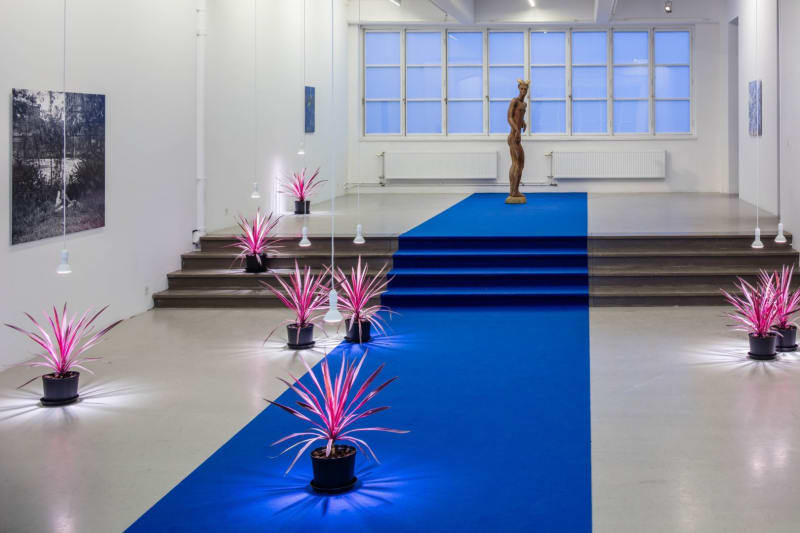Santiago Mostyn - The Warming Plateau : Stockholm
It is with great pleasure we announce the opening of The Warming Plateau, Santiago Mostyn’s first solo-exhibition at the gallery.
The Warming Plateau refers to a set of statistics often used to justify climate change skepticism as they appear to indicate that global average temperatures have been declining over the past fifteen years. However, if one has a more long-term view it is clear that each of these plateaus has been higher than the last, and the world is actually heating up very quickly. The Warming Plateau serves here as a metaphor for looking at the objects and films in the exhibition, in that what may appear as a formalist arrangement – of plants, a wooden sculpture, photographs, a film – is to be understood as connected gestures that relate both to ways of looking at a colonialized past, and to our anthropogenic present.
Central to the exhibition is a film in two parts made on the island of Tobago, an island unique among the former British West Indies in that much of its West African heritage survived the obliterating effects of slavery and exists in vibrant tradition long into the present day. One segment of the film records the largest Silk Cotton Tree on the island, famous for the legend of the ‘African witch’ Gang Gang Sarah who, wishing to return to Africa, climbed the tree and tried to fly, not realizing she had lost her powers. Her story speaks of the impossibility of return.
The other segment of the film shows four men cutting their way through the jungle, making measurements, calling out to each other, working on something that comes into focus as a kind of land claim or marking of distance. The film as a whole is a portrait of the island as a sentient being, showing sites of past and present activity or exploitation.
The arrangement of ‘Rayo’ plants (Cordyline Australis) in the gallery mimics the outline of the plot of jungle being explored in the film, as these plants are traditionally used to mark land boundaries in Tobago, and will in fact be planted when the men complete their work.
Also included in the exhibition is Faun, a work by Luise Kimme (1939-2013), a gesture by Santiago Mostyn that triggers questions about authorship and the right to represent. Kimme was a German sculptor educated at St Martins London, a contemporary of artists such as Gilbert & George and Hamish Fulton, who lived and worked in Tobago since 1979. Faun is representative of her practice, which focused almost exclusively on the black Tobagonian body, with an awkward balance between clear tenderness and the inescapable objectification of her subjects.
Mostyn is a graduate of Yale University, Städelschule in Frankfurt, and the Royal Institute of Art, Stockholm, and has exhibited internationally at venues including Kunst-Werke, Berlin (2008); Turner Contemporary in Kent (2011); Malmö Konsthall (2013); Kunsthall Stavanger (2014); and Moderna Museet in Malmö (2015) and Stockholm (2016). His work was included in the 9th edition of the Göteborg International Biennial for Contemporary Art in 2017 and can currently be seen at Konsthall C, Stockholm. His work has been feature
-
 Santiago MostynInstallation view "The Warming Plateau", Andréhn-Schiptjenko, Stockholm, Sweden, 2018
Santiago MostynInstallation view "The Warming Plateau", Andréhn-Schiptjenko, Stockholm, Sweden, 2018 -
 Santiago MostynInstallation view "The Warming Plateau", Andréhn-Schiptjenko, Stockholm, Sweden, 2018
Santiago MostynInstallation view "The Warming Plateau", Andréhn-Schiptjenko, Stockholm, Sweden, 2018 -
 Santiago MostynInstallation view "The Warming Plateau", Andréhn-Schiptjenko, Stockholm, Sweden, 2018
Santiago MostynInstallation view "The Warming Plateau", Andréhn-Schiptjenko, Stockholm, Sweden, 2018 -
 Santiago MostynInstallation view "The Warming Plateau", Andréhn-Schiptjenko, Stockholm, Sweden, 2018
Santiago MostynInstallation view "The Warming Plateau", Andréhn-Schiptjenko, Stockholm, Sweden, 2018










